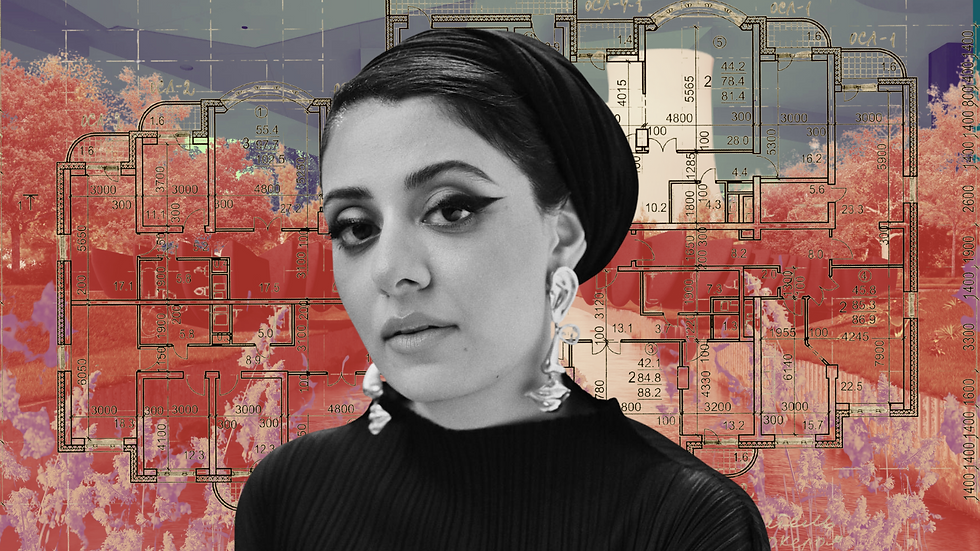Alexandra Daisy Ginsberg: What does “better” really mean – and for whom? Who defines it?
- Charlotte Owen-Burge

- May 6
- 5 min read
Updated: Aug 12

British artist Alexandra Daisy Ginsberg's work asks us to imagine a different relationship with the living world – one where nature is not controlled, commodified or sidelined, but honoured and protected.
Growing up on a farm in the English countryside shaped her early connection to nature, and her background in architecture gave her a systems-level view of how humans shape the world around them. Today, through artworks like Pollinator Pathmaker, Ginsberg invites us to rethink our place in a fragile ecological web.
In this reflection, she shares how her childhood, critical design thinking, and encounters with synthetic biology challenged her understanding of “progress” – and why hope, imagination, and curiosity are more essential than ever.

My connection with nature goes back to childhood. At eight years old, I moved from London to the countryside, where my father grew shiitake mushrooms and cultivated topiary. It was an unusual upbringing – helping pick mushrooms grown the traditional Japanese way on oak logs in the woods, and watching an entire topiary garden take shape. I spent hours trimming hedges, experiencing two very different ideas of nature. The mushrooms – appearing only after a storm or disturbance – seemed almost resistant to cultivation, while the topiary was a kind of exquisite aesthetic torture of plants. In many ways, Pollinator Pathmaker is a rebellion against those ideas of control and design. I was very lucky; my parents deeply valued the importance of spending time outdoors, having farmed rooibos tea in the Cedarberg mountains in South Africa before they moved to the UK, before I was born.
I never intended to become an architect. I wanted to go to art school, but my parents insisted I get a "proper" degree first. Architecture seemed like a creative compromise. Very quickly, I realised that my interests lay not in how buildings stand up, but why we build them at all – why humans make things, what we choose to make, and who decides what is “good.” Studying architecture gave me a systems way of thinking: the ability to think across scales and structures. I respect architects enormously, but I knew that damp-proof membranes were not my passion!
After deciding not to pursue architecture, I discovered a new master's programme at the Royal College of Art: Design Interactions, run by Anthony Dunne and Fiona Raby. They described themselves as critical designers, using design to explore the social, cultural, and ethical implications of emerging technologies. I didn't fully understand it at the time, but it sounded fascinating.
There, I encountered synthetic biology – an emerging form of genetic engineering – and found myself deeply curious about my gut reaction to it. Scientists were talking about programming DNA as though life itself could be designed for human benefit. It was such an instrumentalist view of life that it opened up a whole new practice for me.
I spent the next decade embedded with synthetic biologists, making my own artworks in response, curating projects, and participating in a major research collaboration called Synthetic Aesthetics. We explored whether artists and designers could come “upstream” in scientific development, opening critical conversations while technologies were still forming. Asking: what does it mean to design life? What happens if we question the ethics and impacts as the technology is being created?
Along the way, I realised that much of the language surrounding design and innovation rests on the idea of making the world “better.” But what does “better” really mean – and for whom? Who defines it? I started to see how deeply the assumption of progress is embedded into everything from advertising to urban planning. I reject that blind faith in progress. I'm not in the Steven Pinker camp. By some measures, things might appear to be getting better, but for many – and increasingly for all of us – the worsening impacts of climate change are undeniable.
My work broadened beyond synthetic biology to question the relationship between technology and nature itself. Modern Western culture has severed innovation from preservation, celebrating the “new” while discarding the systems that sustain life. That binary is unsustainable and is, I believe, what will break the system.
There are of course societies that live, and have long lived, in deep connection with the natural world. Their existence proves that humans don't have to behave the way we currently do. Our systems feel entrenched, but culture can change, even if it is very, very difficult.
Art should be transformational. It should transform something inside you.
As an artist, I don't see my role as providing solutions. It's dangerous to measure an artwork like you would a technology or policy. My work is about asking questions – about helping people see differently, connect differently. Art should be transformational. It should transform something inside you.
When I created Pollinator Pathmaker, part of the inspiration came from a review of my earlier work The Substitute – about the extinction of the northern white rhino – which criticised me for “offering no answers.” But how could I offer answers to a problem rooted in political, economic, and social injustice? An artist in London can't solve rhino poaching. What I can do is ask better questions, help people feel differently, think differently, which could lead to change.
Still, I felt a responsibility. Pollinator Pathmaker was my way of offering something practical – agency. It's not going to fix the pollinator crisis, but it empowers people to engage, to take small, tangible actions. Planting a pollinator garden, even a tiny one, involves reclaiming agency, building community, making space for other species. It's a form of creative activism.

Of course, I'm aware that individual actions alone aren't enough. We’ve been sold the lie that carrying reusable bags would save the planet while governments, corporations and systems carry on unchecked. But art can connect people emotionally, spark discussion, make the distant personal. That's where I believe its real influence lies.
Even amid fear and despair, the very fact that humans can imagine a different world means we have the capacity to hope. It’s hard, though. The more afraid I feel, the more paralysed I sometimes become. But I keep going because stopping isn't an option.
The real work – the hard, essential work – is being done by those on the frontlines of ecology, social justice, and policy. As an artist, my role is to tell stories, to create emotional connections, to remind people of their place within the natural world.
That’s what I try to do, whether it’s through a sculpture designed for insects, a tapestry imagined through the eyes of a bee, or an artwork that invites people to imagine a different future.
Because if we can still imagine another world, then we have the ability to make it happen.
This conversation took place on 25 April 2025 and has been edited and condensed for clarity and flow.
Where you can view Alexandra Daisy Ginsberg’s work:
6 June 2025 – 25 January 2026: WEtransFORM New European Bauhaus and Beyond (forthcoming) at Bundeskunsthalle, Bonn, Germany. 6 June 2025 – 25 January 2026
11 July 2025 – 5 October 2025: More Than Human (forthcoming) at Design Museum, London, UK (New tapestry commission). 6 June 2025 – 5 October 2025
17 May 2025 – 22 May 22 2026: Garden Futures: Designing with Nature (forthcoming) at V&A Dundee, Scotland.
2 May 2025 – 10 August 2025: Unearthed: The Power of Gardening at British Library, London, UK (New video commission).
7 March 2025 – 13 July 2025: Echoes of the Past, Promises of the Future at macLYON, Musée d'Art Contemporain de Lyon, Lyon, France.
Main image credit: Portrait of Alexandra Daisy Ginsberg. Photo: © Nathalie Théry. Background Image: Pollinator Pathmaker




Comments